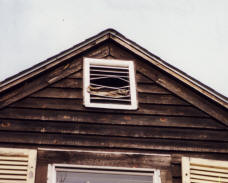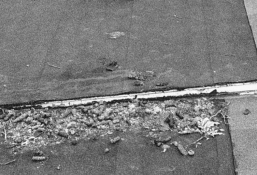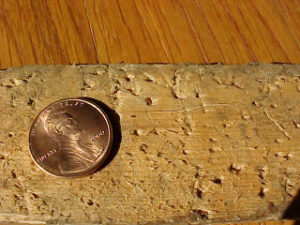Prevention and Species
Inspecting for Raccoon Damage
This lesson consists of key facts and clues that will help you decide if the damage you are seeing could have been caused by this animal. These are key clues but they aren’t necessarily complete. (Humans are learning more all the time and animals change their habits, too.) The information should give you some pointers to at least help you rule out this species as a suspect in your situation.
Weight: 9-26lbs.
Diet: True omnivores. They will eat whatever is available provided they can kill it, including, but not limited to, ants, fish, birds, eggs, small animals, carrion, grubs, worms, trash, etc.
Habitat: All over. Raccoons can be found in wooded and urban environments. They are highly adaptable. They live in trees, chimneys, sewers, attics, under sheds and porches etc.
Activity: Nocturnal (night) /dormant periods during winter months when weather is at extremes.
Reproduction: Mating occurs once a year in January and February. Three to five young are born 6 weeks later. The father does not assist in raising the young. In fact, if a male finds young raccoons, he will eat them.
Symptoms:
A. Attic: Owners will complain of something heavy in the attic that moves during early evening and early morning.
B. Chimney: When raccoons are in a chimney, the owner will complain of bird-like chirping noises emanating from the flue. This will occur during the spring months when the young are born.
Signs: Average hole size is 4 inches in diameter minimum. See vent photo below.
 Access: Raccoons will typically enter a building somewhere high at least one floor off the ground. Attic vents are most common entry ways. Look for the metal louvers to be bent (photo by S. Vantassel). You will also find dark smudge marks made by the animal’s body oils rubbing off on the wood/metal. Smudge marks on gutters/ scratches on wood will give positive sign of raccoon.
Access: Raccoons will typically enter a building somewhere high at least one floor off the ground. Attic vents are most common entry ways. Look for the metal louvers to be bent (photo by S. Vantassel). You will also find dark smudge marks made by the animal’s body oils rubbing off on the wood/metal. Smudge marks on gutters/ scratches on wood will give positive sign of raccoon.
If an overhanging tree branch is at least 1 inch in diameter, then that will be the way the raccoon accesses the building. Look for scratch marks on the tree. During warmer months, they have been known to live under porches. Don’t forget chimney flues. Females especially like to raise young in the chimney smoke chambers. Look for black smudges on the flue tile. Also pay attention to cob webs. If they are present, then you can be reasonably assured that no raccoon has entered that flue. Sometimes looking down the flue with a light will reveal eyes staring back. If you know a raccoon has been in the chimney but are unsure if it is still there, this simple screen will quickly tell you. Just make sure that you are not dealing with birds or bats when using this technique.
Damage to house: Raccoons typically don’t damage houses except for creating an entrance. They have been known to damage roofing tiles. They will mash down insulation as they walk around the attic. Occasionally they will actually enter a building though the shingled roof. Usually there is no damage to the flue tile when entering through the chimney. See Feces below.
Damage to lawn/garden: Raccoon like to eat grubs (and worms) as much as skunks do. However, raccoons tend to peel the sod off the soil to get at the grubs. Skunks, by contrast, just dig a hole where the grub is. I also understand that raccoons can strip a corn husk like a human. Sweet corn is a special favorite.
Fish ponds: Raccoons can and do raid fish ponds. This damage will generally occur during the night and you may notice damage to the plants caused by the raccoon’s struggle to get the fish. If the fish disappear during the daylight hours, think of herons, especially if there is no damage to plant life.

Feces: Raccoons will often create toilet areas, which may be found inside or outside the house. The photo at right is of a toilet found on a roof. Often raccoons living in attics will defecate on the roof before entering the home. You will find the feces on the flat portions or in the drainage area between two roofs. Otherwise, the feces may be found inside the attic, usually well away from the nesting area. The toilet areas may also be identified by the brown staining on the ceiling. Be sure to take appropriate precautions when in close proximity to these latrines. Isolated droppings will look similar to a dog’s. Look for evidence of raccoon food particles in feces such as hairs, corn, etc. (Be careful when handling feces. They may contain eggs of the worm Baylisascaris procyonis, which can cause severe injuries to people).
 Gnaw Damage: Raccoons have sharp pointed teeth. When they bite, you will see definite indentures in the item. In contrast, rodents have four major front teeth. You will see items scraped more than bitten with a ridge line (which is the gap between the front teeth) noticeable. Note photo of a piece of wood which was bitten by a raccoon. Photo by Stephen M. Vantassel.
Gnaw Damage: Raccoons have sharp pointed teeth. When they bite, you will see definite indentures in the item. In contrast, rodents have four major front teeth. You will see items scraped more than bitten with a ridge line (which is the gap between the front teeth) noticeable. Note photo of a piece of wood which was bitten by a raccoon. Photo by Stephen M. Vantassel.
Tracks: Get a book on animal tracks.
Special abilities: Raccoons have an incredible ability to climb. They have been known to climb downspouts, steel I beams, cables, ropes, and corners of buildings. Don’t underestimate their ability to climb.
Safety: Raccoon feces can harbor eggs of Baylisascaris procyonis, a rather dangerous roundworm. To learn more, visit Disease pages on http://icwdm.org. Raccoons are also a vector species for rabies.
©2005 Stephen M. Vantassel